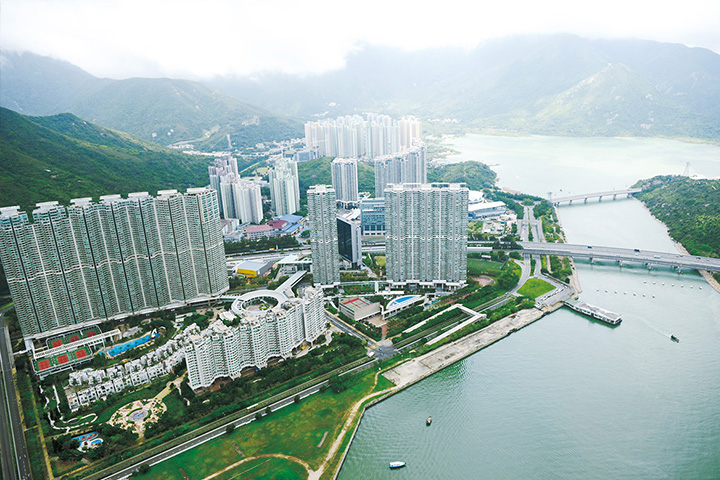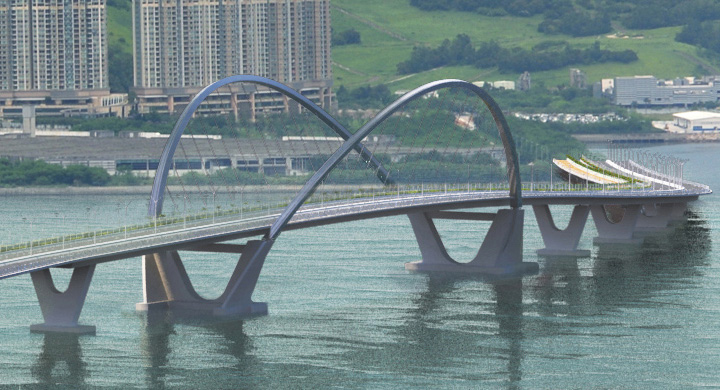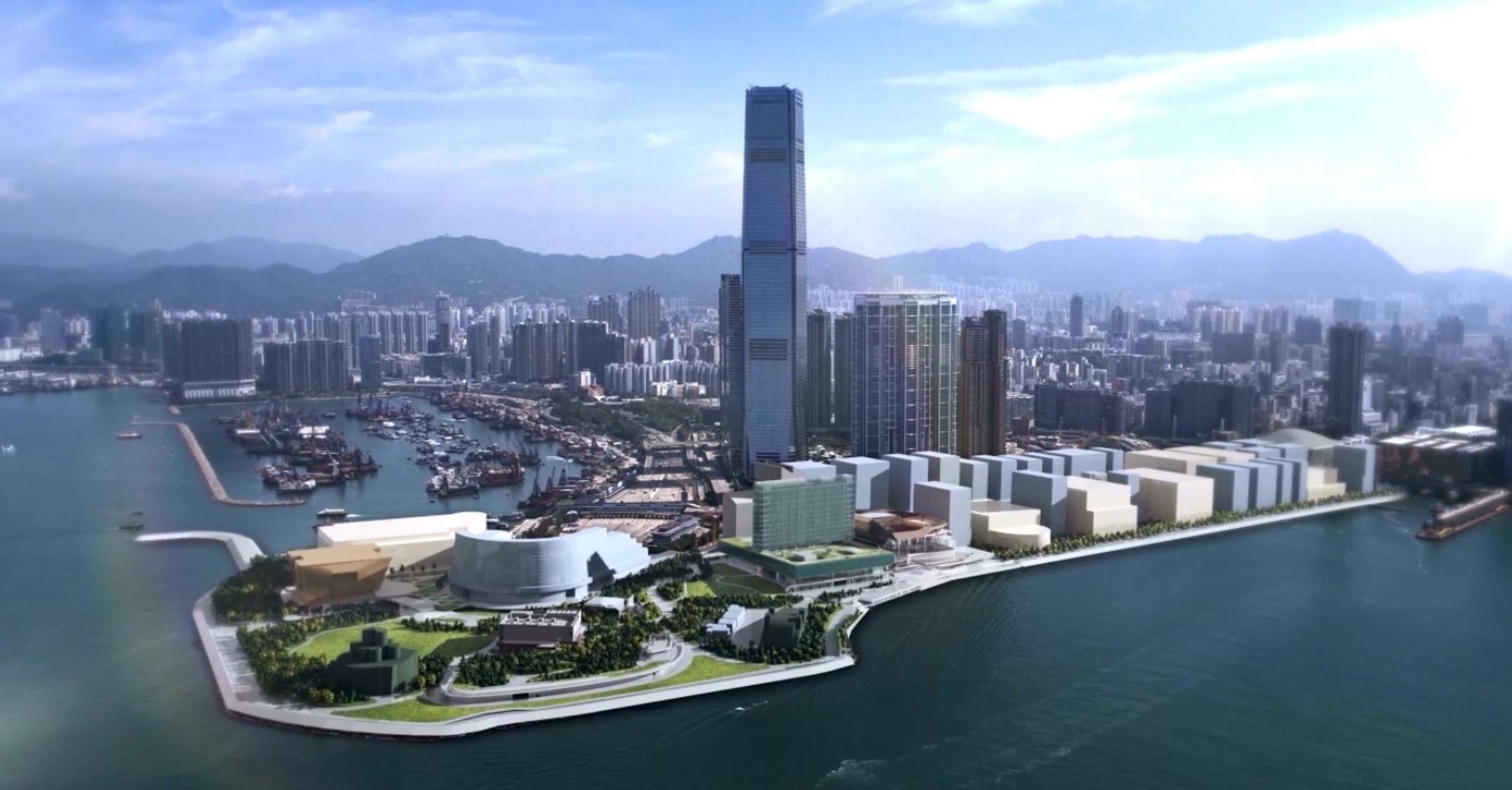Introduction
Provision of land and infrastructure is one of the major service areas of the Civil Engineering and Development Department (CEDD). In the past, we carried out new town development to cope with the increase in population and to improve the living environment by decentralising the population from the over-crowded urban districts. Now, while we would continue to improve the new towns, we are developing New Development Areas (NDAs) and exploring new strategies to enhance land supply. We are also providing or upgrading infrastructure to support the development.
The basic concept for developing a new town is to provide a balanced and self-contained community as far as possible in terms of the provision of infrastructure and community facilities. For major developments, new land will be formed and infrastructure will be provided to allow population growth, to decant existing population and to provide or upgrade facilities to enable the redevelopment of deserted areas. The functional, environmental and aesthetic aspects of the developments are given priority consideration.
New Town Development
Hong Kong has developed 9 new towns since the initiation of its New Town Development Programme in 1973. The target at the commencement of the New Town Development Programme was to provide housing for about 1.8 million people in the first 3 new towns, namely, Tsuen Wan, Sha Tin and Tuen Mun. The population of Hong Kong at that time was about 4.2 million. It is now about 7.50 million.
The 9 new towns can be divided into three generations. The first (Tsuen Wan, Sha Tin and Tuen Mun) started works in the early 1970s, then the second (Tai Po, Fanling/Sheung Shui and Yuen Long) in the late 1970s, and the third (Tseung Kwan O, Tin Shui Wai and Tung Chung) in the 1980s and 1990s. The current population of these 9 new towns is about 3.52 million and is expected to rise to 3.68 million in 2024.
All the new towns accommodate public and private housing supported by essential infrastructure and community facilities. External transport links were developed with all new towns now served by rail links to the urban area and road links to the adjacent districts. Further enhancement of road links is ongoing.
Tung Chung:
We plan to extend the existing Tung Chung New Town into a distinct community to meet housing, social, economic and local needs, and develop the Tung Chung New Town Extension (TCNTE) into a smart and low-carbon community. The TCNTE, comprising developments in Tung Chung East (TCE) and Tung Chung West, will be implemented in phases. The reclamation works in TCE commenced in late 2017 with a view to handing over the first land parcel to Housing Department in 2020 for housing development. The full development of TCNTE is scheduled for 2030.
Tseung Kwan O:
Further development includes lower intensity residential developments at Town Centre South with open parks, recreational facilities and a vibrant waterfront. The cycle track along the waterfront was completed and open to the public in end 2013.
To relieve the traffic congestion of Tseung Kwan O Tunnel and to cope with the traffic demand from further developments in Tseung Kwan O, the construction works for Tseung Kwan O – Lam Tin Tunnel commenced in July 2016 for commissioning in 2021. The construction works for Cross Bay Link commenced in July 2018 for commissioning in 2022.
The planning and engineering study for replanning of Tseung Kwan O Area 137 commenced in December 2016. The study is to examine the feasibility of using the site for residential, commercial and other development purposes.
New Development Areas
New Development Areas in the New Territories:
Previous planning and development studies established the feasibility of developing NDAs in the New Territories, including Kwu Tung North, Fanling North, Ping Che/Ta Kwu Ling (NENT NDAs) and Hung Shui Kiu (HSK NDA).
To formulate proposals for the development and to work out an implementation strategy, a further planning and engineering study on the NENT NDAs commenced in June 2008 and was completed in end 2013. The development proposals of Kwu Tung North and Fanling North NDAs were promulgated to the public in July 2013.
The Kwu Tung North and Fanling North Outline Zoning Plans were approved in June 2015 to provide a statutory framework for the development. The detailed design for the advance works and the first stage works of the Kwu Tung North and Fanling North NDAs commenced in 2014 and has been substantially completed. The scope of the advance works and the first stage works primarily comprises the site formation and engineering infrastructure works at the NDAs, to enable construction of housing and community facilities for the first population intake by 2023 and to provide environmental mitigation measures as pre-requisites for the NDAs remaining packages. The construction works has commenced in the third quarter of 2019.
Ping Che/Ta Kwu Ling NDA is being reviewed and replanned under the preliminary feasibility study on developing the New Territories North. The prime objective of the study is to examine the development potential of the New Territories North, strategic infrastructure provisions required for the development and the development of a modern new town of a scale similar to that of Fanling/Sheung Shui New Town. The preliminary feasibility study commenced in January 2014 and was completed in February 2018. Construction works for the First Phase development of HSK/HT NDA commenced in July 2020 with the first population intake targeted in 2024. Construction works for the Second Phase development of HSK/HT NDA will commence progressively from first half of 2024 with population intake targeting to start from 2030. As regards the expansion of HSK/HT NDA to cover Lau Fau Shan, Tsim Bei Tsui and Pak Nai areas as proposed under the Northern Metropolis Development Strategy, the relevant study commenced in August 2022 with relevant preliminary development proposal released in February 2024.
Potential Development Areas in the New Territories:
To provide more land for future development, we are undertaking planning and engineering study to review the feasibility of converting land in Yuen Long currently used mainly for industrial purposes or temporary storage, or which is deserted, for development. The detailed design for Yuen Long South – stage 1 commenced in February 2018. Meanwhile, the study for Tseung Kwan O Area 137 commenced in December 2016. The investigation and design of the site formation and infrastructure works for Kam Tin South Initial Sites are also anticipated to complete by end 2021 in phases, while the construction of the associated advance works commenced in July 2018.
Lok Ma Chau Loop:
With an area of about 88 ha, the Lok Ma Chau Loop (the Loop) will be developed as the Hong Kong-Shenzhen Innovation and Technology Park (the Park). The scope of the advance works of the Loop primarily comprises land decontamination within the Loop, provision of temporary construction access and creation of ecological area to pave way for the subsequent construction works for the Loop development as well as ground treatment works within the Loop to enable provision of the first batch of land parcels for development of buildings and associated facilities for Phase 1 of the Park. The construction of the advance works commenced in June 2018 for completion by end 2021.
Urban Development Areas
Central and Wan Chai Reclamation:
The Central and Wan Chai Reclamation is being developed in 5 phases for providing land to accommodate strategic road and rail links along the northern shore of Hong Kong Island between Central and Eastern Districts. The first 4 phases have been completed to accommodate, apart from the road and rail links, the Airport Express Hong Kong Station and the Hong Kong Convention and Exhibition Centre Extension. Construction works for the last phase, namely Wan Chai Development Phase II, commenced in end 2009. The reclamation works were completed in 2017 and construction of the remaining infrastructure works is ongoing.
Kai Tak Development:
It is a highly complex development project covering an area of over 320 ha. Forming part of the Energizing Kowloon East initiative, Kai Tak Development (KTD) plays an important role not only to help sustain Hong Kong's economic growth, but also stimulate regeneration of adjacent old districts including Kowloon City, Wong Tai Sin and Kwun Tong.
Given the scale and complexity of KTD, the project is being implemented in phases. The first two batches of projects which include the Kai Tak Cruise Terminal Building and its two berths, public rental housing, Trade and Industry Tower, early phases of District Cooling System and Runway Park, Phase 1 improvement works at Kai Tak Approach Channel and Kwun Tong Typhoon Shelter, Kwun Tong Promenade, two primary schools, reconstruction and upgrading of the Kai Tak Nullah and associated infrastructure works, have been progressively completed since 2013. The Hong Kong Children's Hospital will be put into service in phases by end 2018. Major public works items currently under construction include Kowloon East Regional Headquarters and Operational Base cum Ngau Tau Kok Divisional Police Station, a secondary school, a portion of the Shatin to Central Link, a portion of Central Kowloon Route, further phases of District Cooling System, and various stages of major infrastructure works.
The detailed design for Trunk Road T2, which will form part of the strategic Route 6 comprising the Central Kowloon Route and Tseung Kwan O – Lam Tin Tunnel both under construction, is near completion. The major construction works are scheduled to start in 2019.
We are now proceeding with the second stage of the study for the Environmentally Friendly Linkage System (EFLS) for Kowloon East, which is to explore the EFLS scheme, including its network coverage, alignment and station locations etc., and conduct associated technical assessments to ascertain its feasibility. The way forward for the EFLS project will then be considered.
Anderson Road Development:
The project provided the formation of about 20 ha of land platforms and associated infrastructure, including roads, bridges and greening measures, in Sau Mau Ping for the subsequent development of public housing, schools, open spaces and related government, institution and community facilities. Works commenced in January 2008. All the sites formed for public housing development were handed over to the Housing Department. On Sau Road and On Chui Street have been open to the public for use since January 2016. Also, On Yan Street has been open to the public for use since March 2017. All the infrastructure works supporting the housing development have been completed in advance of the respective phases of population intake.
Development of Anderson Road Quarry Site:
Anderson Road Quarry (ARQ) is located at the southwest ridge of Tai Sheung Tok in East Kowloon occupying some 86 ha of land. The quarry operation ceased in end July 2017. The completion of site formation works would provide a platform of about 40 ha for development of housing, open space, schools, and related government, institution and community facilities. The project also involves major road/ junction improvement works at Clear Water Bay Road, New Clear Water Bay Road and Lin Tak Road, the pedestrian linkage facilities of four routes from the ARQ site to MTR Kwun Tong Station and the proposed Bus-to-Bus Interchange at the Tseung Kwan O Tunnel toll plaza. Site formation works started in December 2016 and are progressing smoothly. The site formation of the first housing development site was completed in end 2017. The first population intake is targeted for 2023/24 onwards.
West Kowloon Cultural District:
The West Kowloon Cultural District (WKCD) project involves the development of a prime waterfront site of about 40 ha, located at the southern tip of West Kowloon Reclamation, into a world class integrated arts and cultural district. The Xiqu Centre, Freespace, M+ and Hong Kong Palace Museum were opened in January 2019, June 2019, November 2021 and July 2022 respectively. CEDD is collaborating with the WKCD Authority to implement the integrated basement and public infrastructure works, which are essential for the WKCD development in stages. In the past few years, we completed the integrated basement of M+ and Lyric Theatre Complex, Museum Drive, MTR Austin Station pedestrian linkage system and Artist Square Bridge etc. The remaining integrated basement and Southern Landing Facility commenced construction in August 2020 and September 2022 for substantial completion in phase in 2028/29 and 2025 respectively. We are planning for the implementation of the public infrastructure works near the toll plaza of the Western Harbour Crossing to support the future development of WKCD thereat.
Provision of Infrastructure
Site Formation and Associated Infrastructure Works for Development of Columbarium, Crematorium and Related Facilities at Sandy Ridge Cemetery:
The Sandy Ridge Cemetery is a potential site for developing columbarium, crematorium and related facilities. The detailed design for the site formation and associated infrastructural works commenced in 2013.
Construction works under the project commenced in December 2017 for completion in phases from 2021 to cope with the development of columbarium, crematorium and related facilities.
New Territories Cycle Track Network:
To improve the quality of living for the public, we have been making efforts in implementing a comprehensive cycle track network connecting the eastern and western New Territories by linking up cycle tracks scattered around various districts, thereby providing the public with more choices for leisure and recreation. The New Territories Cycle Track Network covers an extensive area, starting from Ma On Shan, passing through Shatin, Tai Po, Fanling, Sheung Shui, Yuen Long and Tuen Mun, and will be extending all the way to Tsuen Wan. It comprises two backbone sections with a total length of approximately 80 km. The Tuen Mun to Ma On Shan backbone section of approximately 60 km in length was fully opened in 2020 with a branching off section in Sam Mun Tsai was opened to the public in 2023. The remaining 20 km Tsuen Wan to Tuen Mun backbone section is being implemented in stages with the Tsuen Wan Waterfront section opened to the public in 2021. Over 60 km out of the 80 km cycle track has been completed so far.
Liantang/Heung Yuen Wai Boundary Control Point (Site Formation and Infrastructure Works):
The Connecting Road (named as "Heung Yuen Wai Highway (HWYH)") opened on 26 May 2019, is a dual two-lane carriageway of about 11 kilometres in length, linking Fanling Highway and the Heung Yuen Wai Boundary Control Point (under construction). It comprises a 4.8-kilometre long Lung Shan Tunnel (the longest land-based road tunnel in Hong Kong). HYWH could greatly improve the traffic condition of the North District, especially areas near Sha Tau Kok Road. Besides, after commissioning of the Heung Yuen Wai Boundary Control Point (being constructed under a separate contract of Architectural Services Department), HYWH will serve as a direct driving route and a quick access to the eastern areas of the Greater Bay Area and the nearby provinces.
Development of Land Supply Strategy
Enhancing Land Supply Strategy:
The study on Enhancing Land Supply Strategy (ELSS) by Reclamation outside Victoria Harbour and Rock Cavern Development was completed in end 2014.
We have selected 5 near-shore reclamation sites comprising Lung Kwu Tan, Siu Ho Wan, Sunny Bay, Tsing Yi Southwest and Ma Liu Shui, possible artificial islands in the central waters, and 3 pilot schemes of rock cavern relocation projects comprising Diamond Hill Fresh Water and Salt Water Service Reservoirs, Sai Kung Sewage Treatment Works and Sham Tseng Sewage Treatment Works for further consideration.
We will seek support from the Legislative Council for commencing studies in connection with various reclamation sites, including strategic studies for artificial islands in the central waters to look into the technical feasibility of developing artificial islands in the eastern waters off Lantau and a planning and engineering study for Sunny Bay reclamation. Meanwhile, we are conducting technical studies for some near-shore reclamation proposals. As for the relocation projects, the owner departments of the three selected government facilities have completed the feasibility studies on the pilot schemes to relocate these facilities into caverns, and will proceed progressively with the next phase of work.
Rock Cavern Development:
"Long-term Strategy for Cavern Development" was completed in 2017. With the support of the study findings, the Government prepared and launched a territory-wide Cavern Master Plan in December 2017 to guide and facilitate wider application of cavern development in Hong Kong. A Technical Circular was also issued in end 2017 to promulgate the policy and associated measures related to rock cavern development.
Underground Space Development:
We commenced a Pilot Study on Underground Space Development in Selected Strategic Urban Areas in 2015 with a view to formulating an underground master plan for each of the 4 selected strategic urban areas, namely Tsim Sha Tsui West, Causeway Bay, Happy Valley and Admiralty/Wan Chai and identifying priority projects with preliminary engineering designs developed to facilitate further implementation if needed.













